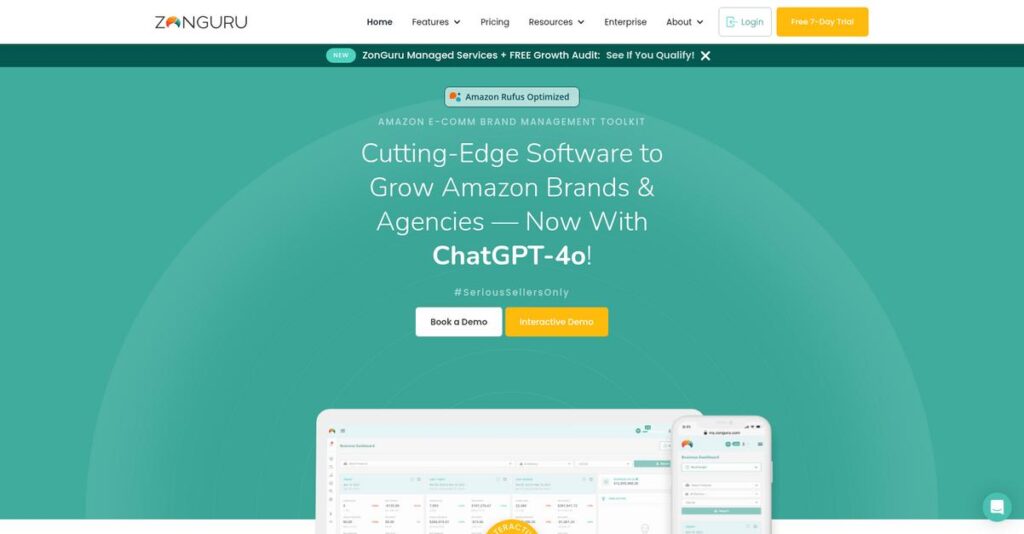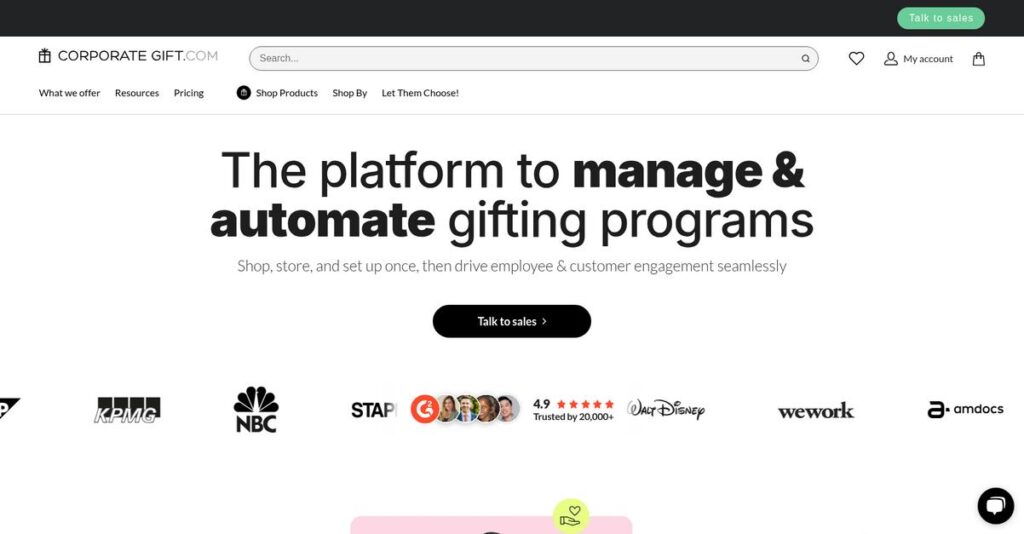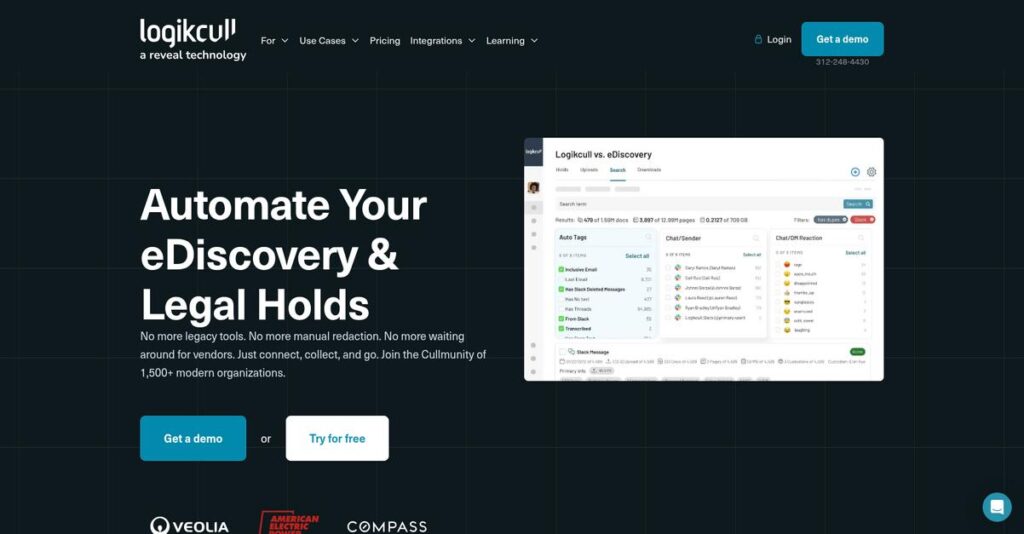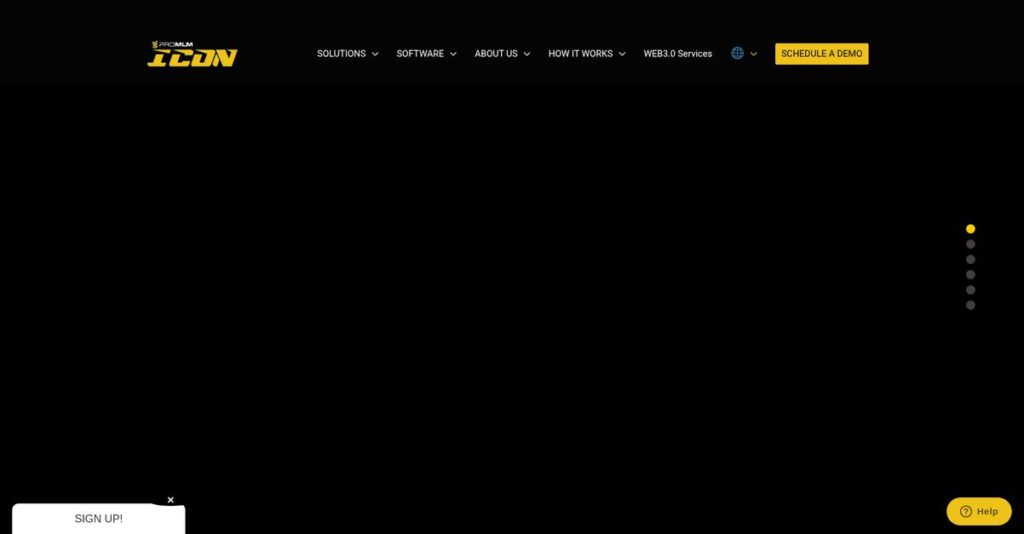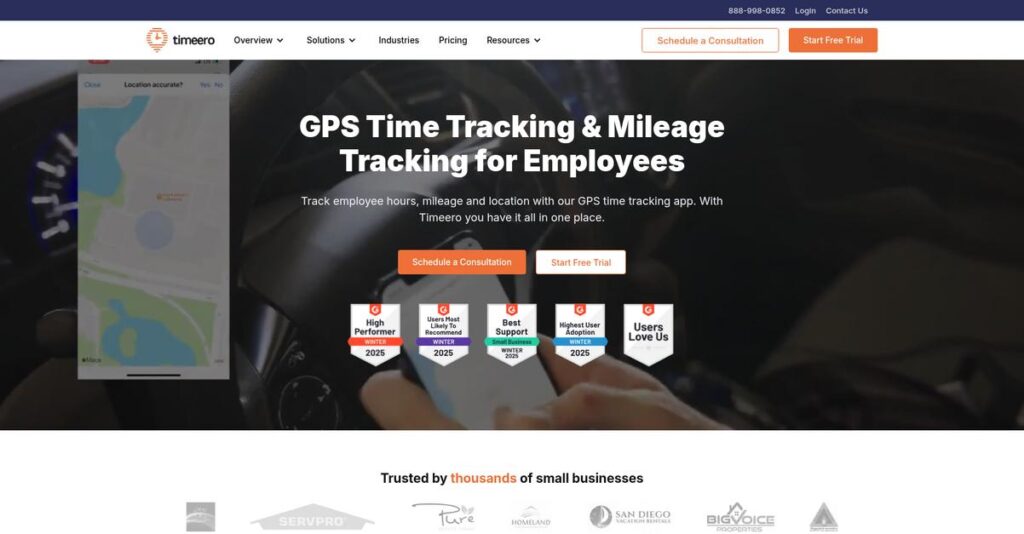Overwhelmed by Amazon seller tools?
If you’re evaluating platforms like ZonGuru, chances are you’re struggling to find reliable ways to discover profitable products, optimize listings, and truly understand your numbers in one place.
And let’s be real: juggling multiple disconnected tools eats up your day, leaving you frustrated trying to make sense of scattered data and missing out on growth.
That’s where ZonGuru stands out. They’ve integrated deep data analytics, AI-powered insights with their “Adam” assistant, and automation across the seller journey—giving you one place for product research, listing optimization, profit tracking, and review management.
In this review, I’ll break down how ZonGuru’s unified approach fixes these time drains using real examples from my own deep dive.
You’ll see, in this ZonGuru review, a hands-on look at features, pricing, real benefits, and how it stacks up against other Amazon seller platforms so you can confidently make your next move.
You’ll walk away knowing the features you need to finally cut wasted time and improve your Amazon results.
Let’s get started.
Quick Summary
- ZonGuru is an integrated platform that helps Amazon sellers find products, optimize listings, and manage business analytics efficiently.
- Best for new to intermediate Amazon sellers looking for a single tool to cover research, optimization, and profitability tracking.
- You’ll appreciate its accurate data, AI assistant “Adam,” and automation features that save time on analysis and review management.
- ZonGuru offers subscription plans starting at $29/month with a 7-day free trial requiring no credit card.
ZonGuru Overview
ZonGuru caught my attention with their clear focus on providing Amazon sellers a comprehensive, data-driven toolkit. They’ve been around since 2016, based in Melbourne, Australia, aiming to support sellers throughout their entire business journey.
What sets them apart is how they focus on small to medium-sized Amazon sellers including private label and wholesale businesses. Their platform covers everything from product research to customer engagement, making it more than just a niche tool but a hub for sellers wanting an integrated experience.
- 🎯 Bonus Resource: Speaking of team development, my guide on best corporate LMS software can help improve your team’s skills and ROI.
A smart development recently was the addition of “Adam,” their GPT-4 powered AI assistant. You can see the impact in how ZonGuru review discussions highlight improved workflow efficiency and actionable insights driven by this AI integration.
Compared to larger platforms, ZonGuru clearly emphasizes providing a seamless, AI-enhanced end-to-end solution rather than just raw data or overwhelming options. Unlike competitors that can feel too complex, ZonGuru feels built by people who understand the day-to-day seller challenges.
They work with thousands of small businesses and individual entrepreneurs who need scalable, accurate tools without an enterprise price tag or steep learning curve.
Lately, their strategy leans into AI-powered insights and usability enhancements, aiming to help sellers make smarter decisions faster, which really aligns with what your business will need in 2025.
Now let’s examine their capabilities.
ZonGuru Features
Finding profitable products feels impossible sometimes.
ZonGuru is a multi-solution platform designed around the Amazon seller lifecycle. These are the five core ZonGuru solutions that tackle product research, listing, AI insights, profitability, and customer engagement with real data-driven power.
1. Product Research (Niche Finder & Sales Spy)
Still hunting for profitable products without reliable data?
Many sellers waste months chasing saturated niches or guessing demand. This uncertainty can stall your growth before you start.
Niche Finder uses advanced filters like revenue and reviews to reveal hidden opportunities, while Sales Spy validates ideas with real-time sales data. From my testing, this solution dramatically cuts guesswork by relying on historical and current market intelligence instead of vague estimates.
This means you can confidently pick winning products and reduce costly launch failures.
- 🎯 Bonus Resource: While we’re discussing product research and meticulous planning, understanding how best takeoff software boosts accuracy is equally important.
2. Listing Optimization (Listing Optimizer & Keywords on Fire)
Struggling to get your listings to rank and convert?
Even great products can get lost without proper keyword targeting and compelling content. This creates frustration when traffic doesn’t translate to sales.
Keywords on Fire pulls top-performing keywords from competitors, and the Listing Optimizer scores your listing live, showing you exactly what’s missing. What I love about this feature is how it offers a step-by-step checklist for listing perfection that balances search ranking and shopper appeal.
This helps your listings stand out and turn clicks into buyers consistently.
3. ZonGuru AI (Adam)
Overwhelmed by data and analysis paralysis?
Decoding market trends and customer feedback manually can eat up hours and miss insights, especially when juggling multiple tasks.
Adam, their GPT-4 powered AI, summarizes niche viability, drafts listing copy, and surfaces product improvements in seconds. Here’s what I found—Adam accelerates decision-making and content creation better than manual methods, acting as a smart assistant across all ZonGuru features.
You save time and get expert guidance instantly, freeing you to focus on growth.
4. Business & Profitability Dashboard
Confused about your real profits and product performance?
Amazon Seller Central reports can be limiting and don’t show full financial clarity, which makes it hard to optimize spend or inventory.
ZonGuru’s dashboard connects directly with your account to display net profit, ROI, and costs with clean charts. From my testing, this feature’s comprehensive financial snapshot helps track product health and ad ROI in one place without guesswork.
This means you get clear insights to prioritize profitable items and cut losses effectively.
5. Customer Engagement & Review Automation
Tired of slow or no customer feedback impacting your ratings?
Manually requesting reviews feels inconsistent and risks violating Amazon’s policies, leaving you with fewer social proof assets.
The Email and Review Automator tools schedule compliant follow-up emails based on delivery status, filtering out refunded orders for safety. This feature smartly builds a more reliable, steady stream of positive reviews while saving you manual follow-up headaches.
This drives higher conversion through strengthened seller reputation and improved ranking.
Pros & Cons
- ✅ Accurate, data-driven product research reduces launch risks
- ✅ AI assistant Adam boosts productivity and insight generation
- ✅ Unified platform covers full Amazon seller lifecycle
- ⚠️ Initial learning curve can overwhelm new users
- ⚠️ Occasional minor bugs reported in some tools
- ⚠️ Pricing is higher compared to entry-level competitors
What makes the ZonGuru solutions stand out is how tightly they work together as a unified, end-to-end Amazon selling platform. You get everything from research to review automation in one place, avoiding tool overload and redundant data entry.
ZonGuru Pricing
Confused about Amazon seller software costs?
ZonGuru pricing is transparent and subscription-based, offering clear tiers for different seller stages. This means you can easily identify which plan fits your Amazon business size and goals without worrying about hidden fees or confusing add-ons.
| Plan | Price & Features |
|---|---|
| Researcher Plan | $29/month billed annually or $49/month monthly • Product research tools (Niche Finder, Sales Spy) • Keyword research (Keywords on Fire) • Listing Optimizer • Access to Chrome Extension & AI assistant • Limited to pre-launch phase |
| Seller Plan | $49/month billed annually or $79/month monthly (starting price) • All Researcher features included • Business Dashboard & Profit Tracker • IP Monitor • Email and Review Automator • Pricing scales with SKU count and order volume |
1. Value Assessment
Clear pricing for every stage.
From my cost analysis, ZonGuru pricing makes smart distinctions between research and active selling phases, so you don’t overpay upfront. The tiered subscription model scales with your SKU count and order activity, which helps you avoid bloated fees as your business grows. Their pricing focuses on giving essential tools aimed specifically at your current selling stage.
Budget-wise, this means your software spend stays proportional to your business size, maximizing value at each level.
- 🎯 Bonus Resource: While discussing software solutions, you might also find my guide on textile industry software helpful for diverse business needs.
2. Trial/Demo Options
Try before you buy.
ZonGuru offers a 7-day free trial without requiring a credit card, which is great for testing core capabilities without upfront commitment. What I found helpful is how the trial provides limited but meaningful access to most tools, giving you a taste of both their research and selling features before deciding on full pricing.
This lets you validate the platform’s fit and avoid surprise expenses when planning your budget.
3. Plan Comparison
Matching plan to business needs.
If you’re still in product discovery, the Researcher Plan fits tight budgets by focusing on market research. As you launch and grow, switching to Seller Plan makes sense because it bundles financial tools, automation, and expanded SKU support. What stands out is how their pricing approach scales with SKU count, ensuring you only pay for the volume you manage.
This helps you align your costs with real usage rather than guessing at growth needs.
My Take: ZonGuru’s pricing thoughtfully supports Amazon sellers by separating research from active selling stages, making it ideal for startups and SMBs seeking budget-friendly yet scalable tools.
Overall, ZonGuru pricing delivers scalable value aligned to seller growth phases.
ZonGuru Reviews
Are ZonGuru reviews truly reliable?
From my review analysis, ZonGuru reviews come from diverse users across platforms like G2 and Capterra, providing a well-rounded view of real customer experiences with the software’s features and support responsiveness.
1. Overall User Satisfaction
Most users express clear satisfaction.
What stood out from the reviews I analyzed is a consistent high average rating near 4.6 stars, with many users highlighting strong confidence in ZonGuru’s data accuracy and responsive customer service. Review-wise, this suggests you can generally expect dependable performance and support.
Key satisfaction drivers include comprehensive features and helpful support, while some note a learning curve as a minor hurdle.
2. Common Praise Points
Users love the platform’s accuracy and support.
From the reviews I studied, customers frequently praise ZonGuru’s reliable sales estimates and in-depth keyword data. The customer support team also earns accolades for being responsive and knowledgeable. These feedback patterns show data accuracy and support as standout strengths in user experience.
This matters because accurate data and support save you time and improve decision-making confidence.
3. Frequent Complaints
Learning curve is a common complaint.
- 🎯 Bonus Resource: Speaking of optimizing operations, my article on best label printing software can streamline your shipping process.
Several reviews mention the initial overwhelm from the platform’s many tools and some minor bugs. What stands out is how users generally find issues manageable due to prompt support responses, as reflected in numerous reviews noting quick problem resolution.
These frustrations appear to be minor and not deal-breakers for most users, especially once they get accustomed to the platform.
What Customers Say
- Positive: “I cross-referenced their sales data with my own for a few weeks, and it was scary accurate. I trust their numbers now.” (G2)
- Constructive: “The number of tools can be overwhelming at first, but the support team helped me get up and running quickly.” (Capterra)
- Bottom Line: “ZonGuru changed how I do product research and listing optimization—worth the investment.” (Trustpilot)
Overall, ZonGuru reviews point to consistently dependable data and knowledgeable support as major reasons users stay satisfied with the software.
Best ZonGuru Alternatives
Too many ZonGuru alternatives to consider?
The best ZonGuru alternatives include several strong platforms, each better suited for different seller sizes, budgets, and specific Amazon business needs. Choosing the right option depends on which features and pricing align closest to your selling strategy and growth plans.
1. Helium 10
Need the most comprehensive toolset?
Helium 10 makes more sense if you’re a power user or a large agency needing the broadest selection of Amazon selling tools including advanced PPC management and deep analytics. From my competitive analysis, this alternative delivers the widest range of features but comes with a steeper learning curve and higher cost than ZonGuru.
You should choose Helium 10 when your priority is accessing the most extensive toolkit and don’t mind paying a premium for it.
2. Jungle Scout
Focused mainly on product research?
Jungle Scout stands out as an alternative if your primary emphasis is discovering new products and verifying suppliers. What I found comparing options is that Jungle Scout’s supplier database and product research are industry leaders, though it offers fewer post-launch management tools than ZonGuru.
For your specific situation, use Jungle Scout when product sourcing is your main concern and you want reliable data without paying for additional features.
3. Viral Launch
Launching a big product line?
Viral Launch is your alternative when you require highly accurate market intelligence and data precision for major product launches. From my analysis, Viral Launch excels in detailed, actionable launch data, making it ideal for sellers treating launches as a critical growth driver, though it lacks ZonGuru’s ongoing optimization support beyond launch.
Choose Viral Launch if you plan large-scale product introductions where pinpoint market insights are more critical than day-to-day operational tools.
- 🎯 Bonus Resource: Before diving deeper, you might find my analysis of appointment reminder software helpful for streamlining client interactions.
4. SellerApp
Need to master Amazon PPC campaigns?
SellerApp appeals as an alternative if advertising management is your top priority. What I found comparing options is that SellerApp delivers powerful AI-driven PPC optimization outperforming ZonGuru’s more balanced seller lifecycle approach, but it doesn’t cover product research and business management as extensively.
You’ll want to consider SellerApp when your primary pain point is managing and scaling Amazon ads effectively.
Quick Decision Guide
- Choose ZonGuru: Balanced tools for product research and business management
- Choose Helium 10: Need the widest set of features for complex selling
- Choose Jungle Scout: Focus mainly on product research and supplier sourcing
- Choose Viral Launch: Planning big launches requiring top market intelligence
- Choose SellerApp: Your main need is advanced Amazon PPC management
The best ZonGuru alternatives depend on which features and pricing fit your selling priorities rather than a one-size-fits-all approach.
Setup & Implementation
Worried about how complex ZonGuru implementation might be?
The ZonGuru review shows that deployment is fairly straightforward but requires some upfront learning and preparation. In this section, I’ll walk you through what you’re really signing up for with ZonGuru implementation so you can set practical expectations.
1. Setup Complexity & Timeline
Setup often seems easier than it actually is.
Getting started with ZonGuru mainly involves creating your account and linking it securely to Amazon Seller Central, which usually takes under 30 minutes. From my implementation analysis, the initial setup is fast but mastering the platform takes longer, especially if you want to tap into all features. Implementation-wise, expect a few weeks to get comfortable beyond setup basics. You’ll want to prepare by allocating time for initial account connection and scheduling learning sessions for your key users.
- 🎯 Bonus Resource: While we’re discussing training and learning, understanding interactive teaching software is equally important for student engagement.
2. Technical Requirements & Integration
Minimal technical hurdles but some integration needed.
ZonGuru runs as a web-based platform, so no heavy software installs are required beyond optionally adding a Chrome extension. What I found about deployment is that integration with Amazon Seller Central via SP-API is straightforward but essential, forming the backbone of your data flow for implementation success. Make sure your IT team or whoever manages your Amazon account credentials is ready to handle API permissions securely and understands basic web access requirements.
3. Training & Change Management
User adoption needs guided encouragement.
The platform includes many tools which can feel overwhelming at first. From my analysis, strong training and ongoing support are critical since core workflows take about a week to grasp, while more advanced features need dedicated practice. ZonGuru’s tutorial videos, live support, and help center are valuable here for smoothing adoption. Your team should plan structured onboarding plus continuous check-ins to reinforce best practices and troubleshoot challenges.
4. Support & Success Factors
Support is a clear advantage during implementation.
ZonGuru’s customer service consistently receives praise for responsiveness and helpfulness. What I found about deployment is that rapid access to live support cuts down learning hurdles and addresses minor bugs quickly throughout implementation. This hands-on vendor support is a key success factor.
Plan for regular interaction with support and consider assigning an internal champion to coordinate with ZonGuru’s team for the smoothest rollout.
Implementation Checklist
- Timeline: Initial setup under 1 hour, learning curve 1-3 weeks
- Team Size: 2-3 users with Amazon account and operational roles
- Budget: Include time for training and possible professional coaching
- Technical: Secure API access to Seller Central and web browser readiness
- Success Factor:1 Consistent training and proactive vendor support usage
From my implementation analysis, ZonGuru implementation scores well for small to medium sellers but requires dedicated training and steady vendor collaboration for the best outcomes.
Who’s ZonGuru For
Who benefits most from ZonGuru?
In this ZonGuru review, I take a close look at which business profiles and operational needs align best with the software’s capabilities. You’ll get practical guidance on fit based on real user patterns rather than generic criteria.
1. Ideal User Profile
Entrepreneurs launching or growing Amazon brands.
ZonGuru fits best if you’re an owner-operator or small team member needing a single platform to manage product research and listing optimization without juggling multiple tools. From my user analysis, private label sellers or wholesalers seeking data-driven decisions but lacking dedicated analytics support will find this fits naturally.
You’ll succeed especially if you want accurate insights combined with easy-to-use automation for everyday Amazon selling tasks.
- 🎯 Bonus Resource: While focusing on optimizing business operations, understanding disaster recovery solutions is equally important for long-term stability.
2. Business Size & Scale
Small to mid-size seller operations thrive here.
Your business ideally involves solo sellers or teams up to around 10 people, where streamlined workflows and integrated dashboards reduce complexity. What I found about target users is that companies with limited staff but growing SKU lists get the most value by avoiding tool fragmentation and subscription overload.
If you manage operations without large departments or sophisticated PPC agencies, ZonGuru will suit your scale well.
3. Use Case Scenarios
Great for launching products and optimizing listings.
ZonGuru excels when your focus lies in early-stage product validation, improving existing listings, and automating tasks like review requests. From my analysis, users benefit most from integrated product research and AI-driven listing improvements across end-to-end seller workflows.
If your day-to-day revolves around managing private label portfolios or growing wholesale lines with fewer manual processes, this software matches your use case.
4. Who Should Look Elsewhere
Not ideal for advanced PPC or large enterprises.
If your business demands deep PPC campaign management, complex multi-user collaboration, or handles very high volumes across many marketplaces, ZonGuru may feel limiting. From my user analysis, enterprises or agencies needing specialized ad tech might find alternatives like Helium 10 or SellerApp better suited.
Consider these if your needs focus heavily on granular PPC control or extensive team workflows.
Best Fit Assessment
- Perfect For: Small Amazon sellers focused on product research and listing tasks
- Business Size: Solo entrepreneurs or teams up to 10 people
- Primary Use Case: Private label product launch and listing optimization
- Budget Range: Mid-tier subscriptions justified by integrated feature set
- Skip If: You need advanced PPC tools or large multi-user collaboration
From this ZonGuru review, you can see that this software fits small to mid-size Amazon sellers focused on managing product opportunities and business growth without complex ad management needs.
Bottom Line
Is ZonGuru the right fit for your business?
My ZonGuru review evaluates its comprehensive toolset and pricing to help you decide if it matches your Amazon selling needs with confidence.
1. Overall Strengths
Comprehensive all-in-one seller platform
ZonGuru excels by combining product research, listing optimization, and business analytics within one interface. From my comprehensive analysis, its proprietary AI assistant “Adam” enhances decision-making by providing contextual insights that streamline seller workflows. Pricing plans scale well with business growth, and users consistently praise the accuracy of sales and keyword data as reliable tools for strategic decisions.
These strengths support improved efficiency and smarter product launches for SMB and entrepreneur sellers alike.
- 🎯 Bonus Resource: Speaking of leveraging data for outreach, my guide on best WiFi marketing software covers additional strategies.
2. Key Limitations
Learning curve and occasional bugs present challenges
Although feature-rich, ZonGuru’s multitude of tools can overwhelm new users initially, requiring time to master. Based on this review, some users report minor bugs and interface quirks that, while usually resolved quickly, may interrupt workflows briefly. The platform’s pricing is higher than simpler entry-level solutions, which might deter sellers with minimal needs or tight budgets.
These limitations are manageable but require realistic expectations about onboarding and investment.
3. Final Recommendation
Recommended for growing Amazon sellers
You should choose ZonGuru if your priority is accessing a complete, data-driven Amazon selling suite that supports product research through post-sale management. From my analysis, the platform offers great ROI for sellers focused on scaling through deeper analytics and smart optimization tools. It suits SMBs and serious private label entrepreneurs ready to invest time learning the platform.
Your next step should be to try a demo or trial to confirm its fit with your workflow.
Bottom Line
- Verdict: Recommended for growth-focused Amazon sellers
- Best For: SMBs and private label entrepreneurs
- Biggest Strength: Accurate data plus integrated AI insights
- Main Concern: Learning curve and higher pricing tier
- Next Step: Sign up for a trial or request a demo
This ZonGuru review concludes with solid recommendation confidence for growth-minded sellers who seek comprehensive, data-driven Amazon tools.
